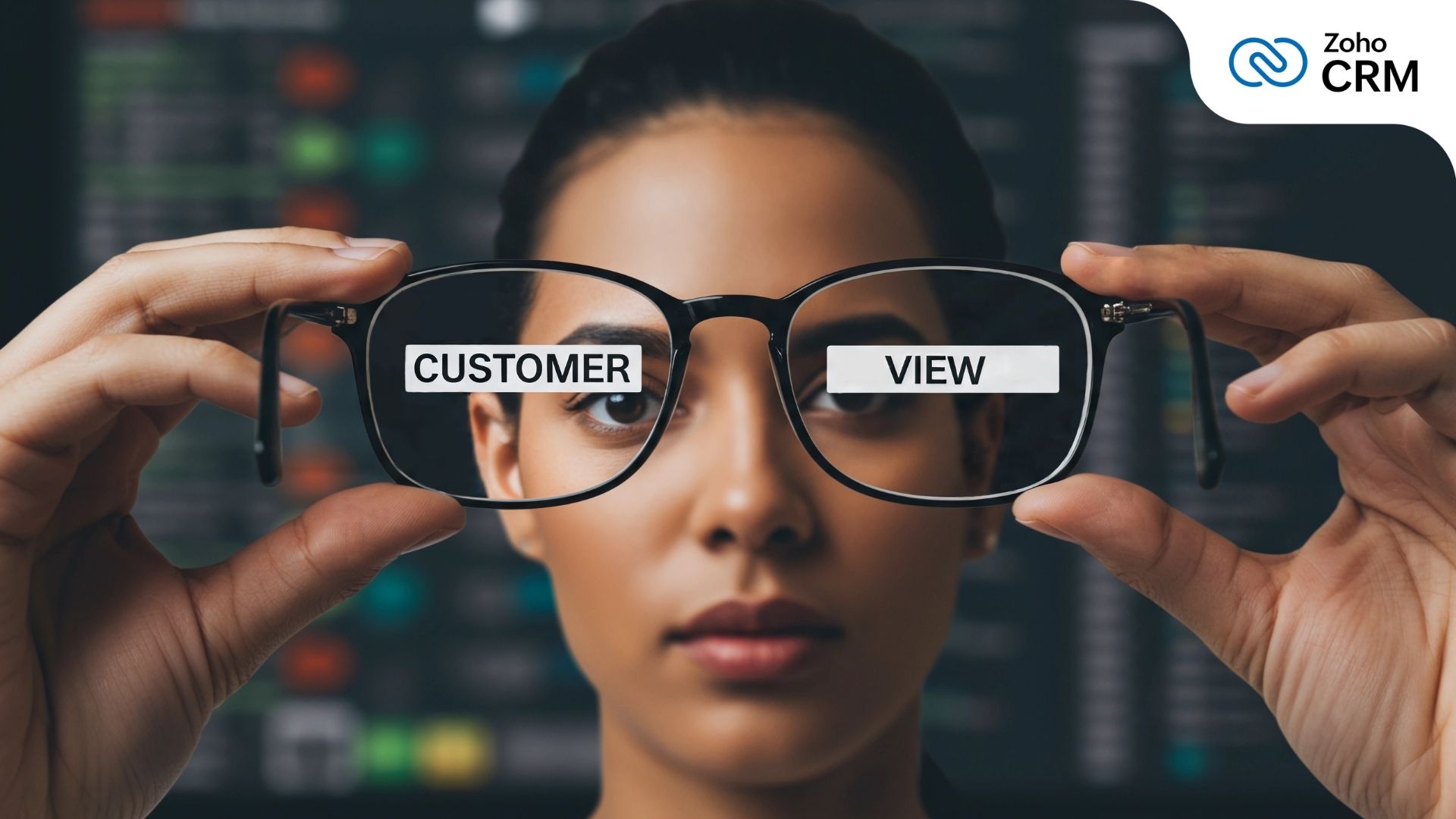The complete guide to winning enterprise deals
- Last Updated : November 6, 2024
- 822 Views
- 11 Min Read

Bagging an enterprise deal is a huge win for any business. Aside from the substantial revenue gain, adding a trusted enterprise brand to your list of clientele can help you position your business confidently in the enterprise market. However, enterprise selling has its fair share of challenges; extended negotiations, technical complications, multiple stakeholders, and longer sales cycles can complicate enterprise selling.
So, what does it take to break into the enterprise market? And what does it take to succeed there? How can you overcome the complexities and challenges in the enterprise market? In this blog, we'll walk you through the critical stages of the enterprise sales process and help you unlock the secret to enterprise selling. But first, let's cover the basics.
What is enterprise sales?
Selling is about delivering positive business outcomes through products or services, or a combination of the two. In enterprise sales, the stakes are higher: the average deal size and deal value are higher, the customers have bigger brands, and the deals are longer and more complex, usually involving multi-year contracts and a lot of risk—for sellers as well as for buyers.
The enterprise sales model is characterized by its long sales cycles, thanks to the technical complexities of implementing solutions, the involvement of multiple stakeholders in decision-making (often reaching all the way up to CXOs), and complicated legal and pricing negotiations required for highly integrated solutions. Enterprise sales also relies heavily on deep relationship building and networking through in-person meetings, events, technical conferences, seminars, and on-site visits.
How is enterprise sales different from SMB or mid-market sales?
On its face, the art of selling is the same whether you're selling to an enterprise, a small business, or a medium-sized company. You're essentially providing a solution for a problem. However, enterprise selling happens at a much larger scale.
Imagine selling produce from your farm in the local farmer's market. You set up shop, customers approach you, assess your product, and make a direct purchase decision right away. Now imagine selling your produce to a large restaurant chain. Large enterprises like these will naturally have a large group of decision makers interested in the quality, supply, and logistics of obtaining your produce—not to mention the finance and legal teams who require iron-clad contracts that guarantee quality, timely delivery, and pricing. This makes the sales cycle a bit more complicated. For businesses selling SaaS or high-tech products, this sales cycle can even stretch on for a couple of years.
The key differences between enterprise selling and SMB and mid-market selling boils down to the following:
- Bigger risks: Enterprise clients usually require custom solutions that are tailor-made for their specific business needs. Building such custom solutions consumes time, money, and resources. Technical requirements such as scalability, stability under intense workloads, and the ability to integrate with the client's existing software and systems also pose significant risks that can prove costly if the deal falls through. With enterprise deals, clients also shoulder a significant portion of the risk, either due to migrating from existing or outdated software or by incorporating new software into their process. The client's financial health—including strategic shifts like mergers and acquisitions, economic and technological changes, or changes in leadership inside or outside the company—all contribute to the risks involved in enterprise deals.
- Longer sales cycle: The enterprise sales cycle is long and laborious, and involves a ton of moving parts. Enterprise sales stages involve conducting extensive research to understand the client's problems, exploring solutions, building requirements, and testing compatibility with pre-existing systems and solutions before putting together an executive pitch. Because enterprise deals involve bigger budgets, there's a lot of scrutiny on the client's end from a large group of stakeholders, each with their own interests at play. This may result in you pitching your solution to multiple stakeholders and trying to gain their confidence.
- Stronger relationships: Developing a deep understanding of customers and building personalized journeys can help win any deal. For enterprise deals, there's simply a stronger emphasis on relationship building. Salespeople might have to engage contextually with different stakeholders, each of which has their own pain points. For example, the head of data security in an enterprise might be more concerned about how strong your solution is against cyberattacks and might take a particular interest in past cyber threats you've thwarted.
Why is enterprise sales important?
As a business grows and evolves, it's natural to want to move up and sell your solution to bigger players with higher risk. Despite the challenges, selling to an enterprise has several benefits:
- Bigger wins: Closing just one enterprise deal can put you ahead of your quarterly or even annual revenue targets. Plus, enterprises usually prefer multi-year contracts instead of one-time purchases. This can put you in a safe place in terms of revenue and enable you to experiment with other enterprises, take bigger risks, and explore newer markets for your product.
- Better brand image: Bagging big-brand enterprise clients enables you to showcase your credibility and cements your brand among other big players. Having brands such as Netflix, Apple, or Google as clients automatically builds credibility and adds value to your own brand.
- Mutually beneficial relationships: Gain one enterprise client, and chances are you're going to be seeing more revenue from them once they're happy with your solution. A land-and-expand strategy is the foundation of enterprise sales. Enterprises can choose to expand the implementation of your solution to other departments, regions, or use cases across their global landscape, which drives further revenue into your business.
The six steps to closing enterprise deals successfully
Selling to enterprises requires a slightly nuanced approach. Unlike traditional sales, where you can apply a tried-and-tested strategy to most leads, enterprise sales can't use a one-size-fits-all strategy. Every opportunity or lead might require a different selling strategy, and you may not be able to re-use selling strategies. However, this doesn't mean you can approach enterprise sales without any strategy at all. Instead, what you need is a sequence of actions that you can customize, adjust, and apply to any big corporate deal.
Step 1: Research and discovery
The easiest way to kill an enterprise prospect is to do no research at all and approach it like any other deal. Once you've qualified and confirmed the prospect is the right fit in terms of company size and the industry, dig deep and find out their pain points. Put yourselves in their shoes; shift the way you think and try to understand the prospect's pain points. Generally, businesses have two kinds of pain points: new and emerging pain points and longer-term challenges that the business has learned to live with. These may be problems that their current vendor can't solve.
An interesting way to discover new pains is to look at business objectives and goals. Then look for the key initiatives in the pipeline to achieve those goals. Gauge how well your solution can help the business implement their initiatives and achieve their objectives. For instance, if the objective for the CFO of a company is to cut down on software spending for the year, check how they plan to achieve it. Are they considering cutting back on some of the software they're using? Are they pulling back on the number of users who have access to this software? Whatever the case, identifying their objective gives you a great opening to pitch your solution—a SaaS spend management solution, for example.
To determine if there are pre-existing business problems their current vendors are unable to solve, try to find channels where the prospect's employees discuss them. Look for conversation threads on LinkedIn where the founders or top-level staff have raised issues with their vendors. Make a note of them and showcase how your solution can effectively combat these issues.
Once you've identified the pain point and confirmed that your solution can help, put together a plan of action to tackle questions that may arise. This way, you'll be able to overcome objections even before they arise.
Stage 2: Build trust
Building a strong and mutually beneficial relationship in the enterprise segment requires focusing on the general enterprise audience and the "champions" among them.
Build a solid relationship with the "champion" within the enterprise
Closing an enterprise deal is a long-term project, one that requires practice and patience. It's rare—impossible, even—that you get to talk to the enterprise buyer in the initial phase. At best, you might get a chance to talk to a mid-level executive who might put you in touch with the head of his business unit, who may or may not be the enterprise buyer. So it's critical to nurture the relationship with your primary contact. Later in the sales cycle, they might become the "champion" internally advocating and connecting you with senior management.
Discover your champion's roles and responsibilities; understand their priorities through their digital presence. Find mutual ground on which to connect, and continue to nurture this relationship. Share meaningful content, interesting case studies, use cases, and hacks for utilizing your solution more effectively. Remember, this champion will have to gain executive buy-in internally even before you get a seat at the executive table.
Build trust with the enterprise audience
It's impossible to gauge who might be on the executive panel that makes the final purchase decisions for enterprise deals. So in the beginning, focus on building solid rapport with as many people as possible on the prospect's side. Leverage your own executive team, find and establish connections within the prospect company, and get references through known connections.
Cast a wider net for multiple enterprise prospects through a combination of thought leadership, PR, and branding activities. Look for specific industries where your solution fits into solving a major problem. Attend conferences, join discussions, secure speaking slots, and publish meaningful content that addresses industry-wide concerns. Leverage your PR team to secure sponsored posts and conduct organic interviews in popular business publications. Discover publications that prospects in those industries prefer, and get those publications to talk about your awards and achievements.
Regardless of whether you connect with a single enterprise contact or address a wider audience, the objective is to build an emotional connection on top of your product's functionalities by showcasing the value you can add to the prospect's business.
Stage 3: Tailor the solution
Investigative research can tell you a lot about an enterprise's priorities and its current needs. However, there's nothing like getting a seat at the table, as it can give you a deeper understanding of the prospect's core problems and related miscellaneous problems, as well as help you learn the nuances of their culture and why it's critical for them to solve their business problem. Also, enterprise requirements evolve, mature, and grow in response to business challenges, competition, and growth strategies. That's why it's important to tailor your offerings in response to evolving requirements.
Adopt a consultative approach and partner with the prospect as a consultant or a solution advisor and see how you can tailor your solution to solve their business problems. Articulate their problems into achievable goals and work with your own internal teams to understand the prospect's needs.
Simply look at the value that your solution can add and pay attention to the ROI and your solution's long-term benefits. Devise ways to enhance these benefits and minimize the risks involved in using your solution.
Step 4: Refine your sales pitch and handle objections
When presenting to an enterprise audience, it can be tempting to showcase every shiny aspect of your product. But it's better to trim down your pitch and deliver what your solution can do in no more than two minutes. Here's a simple template: Solution A can help enterprises achieve B through C. Where A is your solution, B is a value derived out of solving a business problem, and C is how you plan on solving the problem. Without these elements, your pitch might seem hollow. For instance, you can pitch your online meeting scheduling solution to help enterprises cut down on the time taken to plan the meetings by 30% by incorporating a calendar for booking meetings.
Once you've presented the solution and its value, back up your claim with use cases. Showcase how other enterprises have achieved great results. Spend time explaining how you approached the problem, the roadblocks you faced and how you worked around them, and how the results led to better ROI, productivity, efficiency, or efficacy.
Once you've covered all these bases and answered questions about the solution, it's time to tackle objections related to interoperability, scalability, adaptability, adoption, migration, pricing, security, legality, and contracts. Address these concerns with patience and promise only what you can deliver. If any objection arises that requires further help from your internal teams—finance, legal, contracts, security, or even the development—don't hesitate to loop them in to field questions.
When you get templated responses like, "This is not a priority for us right now," "We already have a solution in mind," "We're leaning towards the competition," "We need to check with the CXO," or something similar, use empathy; acknowledge their concerns, ask questions, and get a clear picture. Find ways to link the value of your solution with their concerns and close strong.
Step 5: Implementation and customer support
Having a talented sales team amounts to nothing if your implementation team doesn't or isn't able to deliver on the promise on time. To avoid this trap, introduce the implementation team to the prospects early on in the sales cycle. Assign dedicated sales reps for enterprise accounts and ensure they're present throughout all of the deal's stages, starting from finalizing the solution, POC, sandbox testing, contract negotiations, finalizing the agreement, and finally implementation and onboarding.
Provide dedicated workspaces where internal stakeholders and the sales team can communicate, collaborate, and track project progress within your CRM. Create workflows and due dates for each process, and give everyone a space to converse contextually.
Create internal metrics and KPIs to track the progress of the implementation. Assign deadlines and reward accomplishments. Track project progress periodically and question deviations from the planned project path. Identify delays as they occur and inject additional resources to keep the project on track.
Step 6: Nurture the relationship
Signing the dotted line doesn't signal the conclusion of the enterprise sales process. Enterprises tend to stick to a vendor for the long haul, and they prefer to run all their systems under a single roof. For example, if they're using your document management solution for just one region or department, chances are, other departments or branches are now ripe prospects to pitch your solution.
Keep in touch with your champion. Arrange in-person meetups. Visit the company's offices, if possible. Get the hang of their culture. Introduce yourself to other teams within the enterprise. Be curious and learn what issues plague them, and offer genuine support—even if you don't have a direct solution that can solve the problem.
Get your leadership team to check in with their leadership team. Plan workshops, training sessions, and user conferences to train new and existing users.
Observe product adoption and usage rates if you're in the SaaS business. Devise ways to boost solution adoption. Recruit pit crews and have them train their own staff on product usage to boost adoption. Be attentive to feedback and make improvements in your product to address new and interesting use cases that they bring up.
Conclusion
Enterprise sales don't happen overnight. They can be tiring and time-consuming, but the benefits far outweigh the effort and costs involved. In terms of revenue, brand recognition, and referral revenue, there's nothing like enterprise deals when it comes to boosting your business and putting you on the path to sustained growth.


